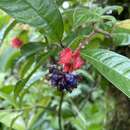ar
الأسماء في صفحات التنقل


Crantzia ist eine Pflanzengattung aus der Familie der Gesneriengewächse (Gesneriaceae). Die etwa vier Arten kommen in der Neotropis vor.
Crantzia-Arten sind mehrjährige krautige Pflanzen oder Halbsträucher. Sie wachsen epiphytisch oder terrestrisch. Die einfachen Laubblätter stehen meist gegenständig.
In den Blattachseln stehen die Blüten meist zu wenigen zusammen oder sie stehen einzeln. Die zwittrigen, zygomorphen Blüten sind fünfzählig mit doppelter Blütenhülle. Die fünf Kelchblätter sind fast frei. Die fünf Kronblätter sind röhrig oder tellerförmig verwachsen. Die vier Staubblätter hängen mehr oder weniger zusammen.
Die zweiklappigen Kapselfrüchte enthalten viele winzige Samen.
Die Gattung Crantzia wurde 1777 durch Giovanni Antonio Scopoli in Introductio ad historiam naturalem sistens genera lapidum, plantarum, et animalium hactenus detecta, caracteribus essentialibus donata, in tribus divisa, subinde ad leges naturae., S. 173 aufgestellt. Der Gattungsname Crantzia ehrt den Arzt und Botaniker Heinrich Johann Nepomuk von Crantz.[1] Der Name Crantzia Scop. hat eine komplizierte botanische Geschichte. Erschwerend hinzukommen noch mehrere Homonyme.
Durch John L. Clark wurden 2005 drei Arten aus der Gattung Alloplectus in die Gattung Crantzia eingegliedert. Synonyme für Crantzia Scop. sind: Lophia Desv. nom. illeg., Lophalix Raf., Heintzia Karst., Prionoplectus Oerst.
Die Gattung Crantzia ist in der Neotropis verbreitet. Das Hauptverbreitungsgebiet sind die Karibischen Inseln. Eine Art gibt es in Venezuela, und eine Art gedeiht auf dem Guayana-Schild.
Es gibt etwa vier Crantzia-Arten:
Crantzia ist eine Pflanzengattung aus der Familie der Gesneriengewächse (Gesneriaceae). Die etwa vier Arten kommen in der Neotropis vor.
Crantzia is a plant genus in the family Gesneriaceae. Crantzia species grow in damp or wet forests, mostly on Caribbean islands. Some are epiphytes, others are subshrubs or herbaceous plants with fibrous roots.[3]
Several taxa from the Gesneriaceae genus Alloplectus have been reclassified as Crantzia.
Giovanni Antonio Scopoli named the genus after botanist and physician Heinrich Johann Nepomuk von Crantz (1722–1799).[3]
Crantzia is a plant genus in the family Gesneriaceae. Crantzia species grow in damp or wet forests, mostly on Caribbean islands. Some are epiphytes, others are subshrubs or herbaceous plants with fibrous roots.
Several taxa from the Gesneriaceae genus Alloplectus have been reclassified as Crantzia.
Giovanni Antonio Scopoli named the genus after botanist and physician Heinrich Johann Nepomuk von Crantz (1722–1799).
Crantzia es un género con 61 especies de plantas herbáceas perteneciente a la familia Gesneriaceae.[2] Es originario de América.
Son subarbustos de hábitos epífitas o terrestres o hierbas gruesas con raíces fibrosas. Los tallos son cilíndricos o cuadrangulares, muy ramificados. Las hojas son opuestas, pecioladas, las láminas elípticas a ovadas, con el margen entero o serrado. Las inflorescencias en cimas axilares, con pocas flores, bracteoladas. Flores resupinadas (excepto C. tigrina). Sépalos casi libres, de color verde, ovadas en general, todos fuertemente serrados, pubescentes o pilosos. Corola tubular, de color amarillo o rojo. el fruto es una cápsula bivalva carnosa rodeada por el cáliz persistente con numerosas semillas, longitudinalmente estriadas. El número de cromosomas : 2n = 18.[1]
Se distribuyen principalmente en el Caribe, una sp. en Venezuela, otra en las Guayanas. Son plantas trepadoras de hábitos epífitas o terrestres ; que crecen en los bosques húmedos y mojados.[1]
El nombre del género fue nombrado en honor Heinrich Johann Nepomuk von Crantz (1722-1797), un médico y botánico reconocido, nació en el Gran Ducado de Luxemburgo y la práctica la realizó en Viena bajo el reinado de la emperatriz María Teresa.
Crantzia es un género con 61 especies de plantas herbáceas perteneciente a la familia Gesneriaceae. Es originario de América.
Buxus é um género botânico pertencente à família Buxaceae. É conhecida por buxo[1] ou buxeiro[2].